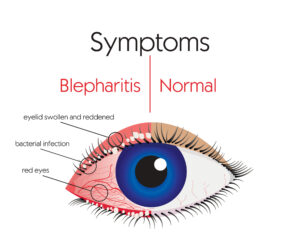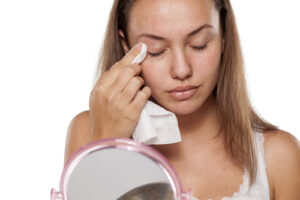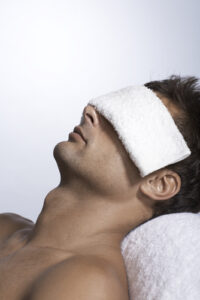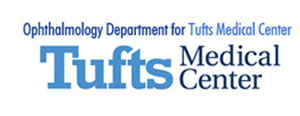Do your eyes feel dry, itchy, or irritated? These are signs of a condition called dry eye syndrome.
Dry eyes are prevalent and can happen for several reasons. Often, dry eyes are temporary and triggered by environmental changes, like drier weather.
Sometimes, they may be caused by certain medical conditions or as a medication’s side effect. But one of the main things that contribute to dry eye is inflammation and inflammation of the eyelids.
Inflammation of the eyelids is also called blepharitis. Some people are more prone to blepharitis than others. The good news is that there’s a reliable way to manage blepharitis and ease dry eye symptoms at the same time by practicing lid hygiene.
Keep reading to learn if lid hygiene for dry eyes works!
What is Blepharitis?

Blepharitis is usually the result of a bacterial infection. Harmful bacteria get into the conjunctiva, which lines the inside of your eyelids. When this occurs, it makes the area reddened and inflamed.
Blepharitis can irritate your eyes, but it can dry them out by affecting the meibomian glands. The meibomian glands are what produce lipids.
Lipids are the oil that coats your tears, which are essential for good tear health. Blepharitis can lead to meibomitis, the inflammation of the meibomian gland. Meibomitis then can lead to meibomian gland dysfunction.
Meibomian Gland Dysfunction
Meibomian gland dysfunction (MGD) is one of the leading causes of dry eye. It can happen for many reasons, but one common way to develop it is through blepharitis and meibomitis.
When inflamed, the meibomian gland can struggle to produce enough lipids because the lipids become backed up in the swollen glands. The more backed up the lipids become, the harder it is for them to flow out of the glands.
When your tears cannot flow out of the meibomian glands, your tears aren’t coated in oil. Without the protective oil film, your tears evaporate too quickly on the surface of your eye, eventually drying your eyes out.
Eyelid inflammation is the beginning of this cycle that triggers dry eyes and keeps them dry as long as your eyelids and meibomian glands stay inflamed. One way to treat dry eyes is to stop this cycle by clearing up the bad bacteria that cause the inflammation. The best way to do that is to practice lid hygiene.
What is Lid Hygiene?

Lid hygiene is precisely what it sounds like: making sure your eyelids are clean. Lid hygiene is as simple as washing your face daily for many people.
Keeping your face clean is an excellent way to lower your risk for eyelid inflammation, especially if you wear eye makeup. Ensuring that you remove all your makeup before going to bed is essential for good lid hygiene.
But even if you are diligent about face washing, you can still get inflamed and dry eyes. Dry eye syndrome is common, especially in older adults and women.
The chronic condition often happens due to complications from eyelid inflammation and meibomian glands. If you develop blepharitis or dry eye symptoms, there are more steps you can take to make sure that your eyelids are clean.
Good lid hygiene practices can prevent and treat blepharitis and associated complications.
Lid Hygiene Techniques
Practicing lid hygiene techniques are ways you can make sure your eyelids are clean. One easy way to do this is to place a warm compress over the eyes.
Place a Warm Compress Over the Eyes

Using a warm compress can give you immediate relief from mild inflammation. Often more intensive treatment is needed to keep your eyelids clean and ease inflammation and accompanying dry eye symptoms.
Clean Eyelids with a Cleansing Solution
The best way to keep your eyelids clean is to keep them as clean as possible. Cleaning your eyelids involves simply rubbing your eyelid gently with a cleansing solution and then rinsing thoroughly with cool water.
Before washing your eyelids, consult your eye doctor to discuss what techniques and cleaning solutions you should use. They may prescribe you special wipes or a specific cleaning solution.
They also tell you how you can make your own cleaning solution. Homemade eyelid wash is often made with a gentle soap, like baby shampoo, mixed with water.
You can apply this wash with a washcloth to your eyelids. But be sure to ask your eye doctor before adopting a lid hygiene routine.
If you struggle with dry eyes, regular eyelid cleaning can help immensely. When performed regularly, these dedicated lid hygiene practices can clear up existing symptoms of dry eye and blepharitis and keep your eyelids and meibomian glands from becoming infected again.
Stay Hydrated and Eat the Right Foods

There are also other ways to treat dry eyes and maintain good eye health. These practices include staying hydrated and getting the proper nutrients.
In particular, ingesting omega-3 fatty acids can help improve healthy tear production. But good lid hygiene is a must for anyone with dry eyes and should be incorporated into any treatment plan for dry eyes.
If you find your eyes are frequently inflamed and feel dry, irritated, or cause you discomfort, see your eye doctor. They can provide you with a clear diagnosis and discuss creating a thorough lid hygiene routine and other recommended treatment forms.
Do you want to learn more about treating dry eyes? Schedule an appointment at New England Eye Center in Boston, MA!
Haven’t you lived for long enough with the frustrating symptoms and discomfort that having dry eyes causes?




